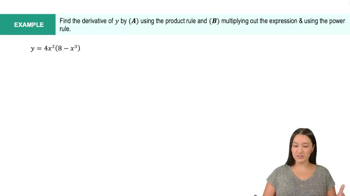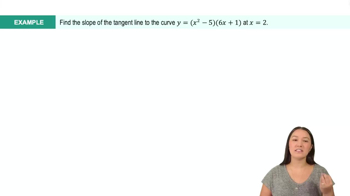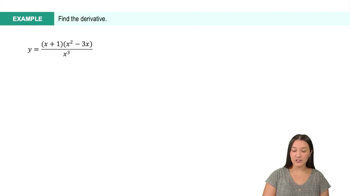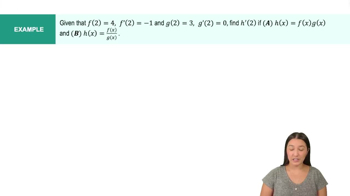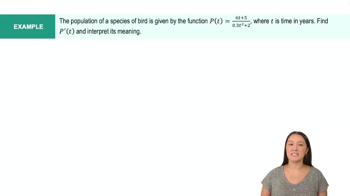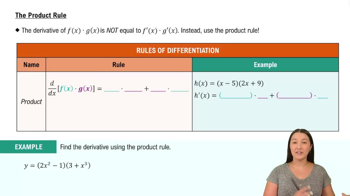Table of contents
- 0. Functions7h 52m
- Introduction to Functions16m
- Piecewise Functions10m
- Properties of Functions9m
- Common Functions1h 8m
- Transformations5m
- Combining Functions27m
- Exponent rules32m
- Exponential Functions28m
- Logarithmic Functions24m
- Properties of Logarithms34m
- Exponential & Logarithmic Equations35m
- Introduction to Trigonometric Functions38m
- Graphs of Trigonometric Functions44m
- Trigonometric Identities47m
- Inverse Trigonometric Functions48m
- 1. Limits and Continuity2h 2m
- 2. Intro to Derivatives1h 33m
- 3. Techniques of Differentiation3h 18m
- 4. Applications of Derivatives2h 38m
- 5. Graphical Applications of Derivatives6h 2m
- 6. Derivatives of Inverse, Exponential, & Logarithmic Functions2h 37m
- 7. Antiderivatives & Indefinite Integrals1h 26m
- 8. Definite Integrals4h 44m
- 9. Graphical Applications of Integrals2h 27m
- 10. Physics Applications of Integrals 2h 22m
3. Techniques of Differentiation
Product and Quotient Rules
Problem 3.R.84C
Textbook Question
Use the given graphs of f and g to find each derivative. <IMAGE>
c. d/dx ((f(x) / g(x)) |x=3
 Verified step by step guidance
Verified step by step guidance1
To find the derivative of the function \( \frac{f(x)}{g(x)} \) at \( x = 3 \), we will use the Quotient Rule. The Quotient Rule states that if you have a function \( h(x) = \frac{f(x)}{g(x)} \), then its derivative \( h'(x) \) is given by \( h'(x) = \frac{f'(x)g(x) - f(x)g'(x)}{(g(x))^2} \).
First, identify \( f(x) \) and \( g(x) \) from the graphs at \( x = 3 \). Determine the values of \( f(3) \) and \( g(3) \) from the graph.
Next, find the derivatives \( f'(x) \) and \( g'(x) \) at \( x = 3 \). This involves determining the slopes of the tangent lines to the graphs of \( f \) and \( g \) at \( x = 3 \).
Substitute the values \( f(3) \), \( g(3) \), \( f'(3) \), and \( g'(3) \) into the Quotient Rule formula: \( h'(3) = \frac{f'(3)g(3) - f(3)g'(3)}{(g(3))^2} \).
Simplify the expression obtained from the Quotient Rule to find the derivative of \( \frac{f(x)}{g(x)} \) at \( x = 3 \).
 Verified video answer for a similar problem:
Verified video answer for a similar problem:This video solution was recommended by our tutors as helpful for the problem above
Video duration:
4mPlay a video:
Was this helpful?
Key Concepts
Here are the essential concepts you must grasp in order to answer the question correctly.
Derivative
The derivative of a function measures how the function's output value changes as its input value changes. It is defined as the limit of the average rate of change of the function over an interval as the interval approaches zero. Derivatives are fundamental in calculus for understanding rates of change and are denoted as f'(x) or df/dx.
Recommended video:

Derivatives
Quotient Rule
The Quotient Rule is a formula used to find the derivative of a function that is the quotient of two other functions. If h(x) = f(x) / g(x), the derivative h'(x) is given by h'(x) = (f'(x)g(x) - f(x)g'(x)) / (g(x))^2. This rule is essential when differentiating functions that are divided by one another.
Recommended video:
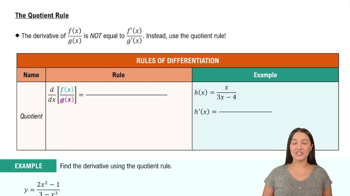
The Quotient Rule
Evaluating Derivatives at a Point
Evaluating a derivative at a specific point involves substituting the x-value into the derivative function. For example, to find d/dx (f(x) / g(x)) at x=3, you first apply the Quotient Rule to find the derivative and then substitute x=3 into the resulting expression. This process provides the instantaneous rate of change of the function at that particular point.
Recommended video:

Critical Points
Related Videos
Related Practice



